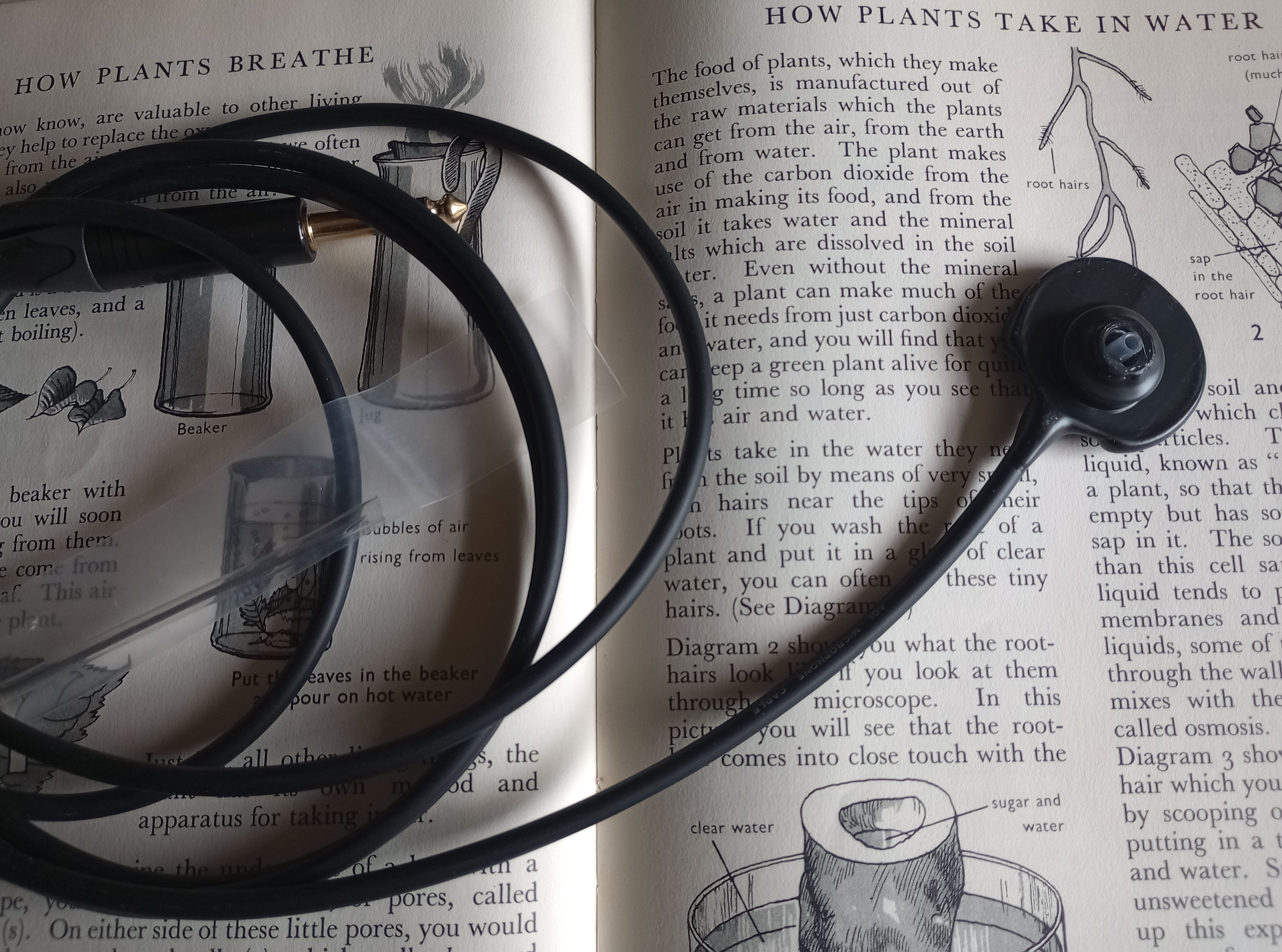JRF C-SERIES+ 'ECOUTIC' ADAPTED CONTACT MICROPHONE
The 'ecoutic' adaptation is suitable for use in ecoacoustic research and creative sound practices.

An adapted version of the now iconic c-series microphones that have been at the forefront of creative sound and scientific research for many years, leading the way in new techniques to explore sounds in the soil, plants, trees, architecture and in performance. They’ve been part of ground breaking studies, shifts in knowledge about multiple species, installations, exhibitions, albums, award winning documentaries, films and games, and, of course, a vast range of artistic works, across forms & genres.
£60 inc. c-cm+ mic with fitted adaptor + 2 probes (UK)
£65 inc. c-cm+ mic with fitted adaptor +2 probes (rest of world)
postage options include 1st class, special delivery, tracked etc
with neutrik jack and 2m cables as standard
supplied with 2 probes, with the choice of medium and 2 sizes of long
(spare probes are also available for an additional cost)
*if you have the budget we do suggest using the ecoutic mic with the impedance adaptors to XLR (£25), as this improves the frequency response further
This adaption is based on the mics that Jez and Pheobe use in some of their own work and research , and allows different sized, interchangeable probes to be attached easily to the microphone. They were developed alongside the techniques that Jez devised.
As with every JrF microphone, ethics and the principle of quality sound at a reasonable price has guided the process, with each part of the adaptation being sourced from recycled or sustainable materials where possible, microphone elements that are custom built for the widest frequency response + acoustic transfer coatings.
The adaptation is attached to a c-cm+ mic. We could have created a new, bespoke part but the additional cost to customers and environmental impact was an issue, therefore we are using parts already in production for other uses. We have however worked with manufacturers to increase the use of recycled materials and to remove coatings on the adaptors and probes that can affect some insect species.
*further advice and IMPORTANT INFORMATION on how to use the ecoutic microphone can be found below & via this link.
probe sizes;
medium probes are, currently, supplied as 1.75inch (inc. hub).
long probes are available in either 3inch or 4inch versions (inc. hub).
EU / NI: until the new GPSR regulations are clearer, all items for sale are from current batches & therefore have been placed on the market prior to December 2024.
all products & designs p&c JrF
the c-series+ ‘ecoutic’ adaptation - general advice (additional advice is available on the plant-tree-soil recording page)
. As mentioned, this adaptation uses parts already in various manufacturing systems, to keep costs affordable to customers and reduce additional environmental impacts. Apart from using this adaptation in our own works (see moss listening, ink botanic, soil horizons and secret sound of trees) we carried out extensive research on different ways to approach the adaptation, in consultation with leading ecoacoustic researchers from across the world. We firmly believe, as with other JrF mics, that the version we are making available represents the best balance between outstanding results and cost. In terms of sensitivity, frequency response and the overall sound they significantly out perform soil monitoring systems costing several hundred GBP / Euro’s, and expand this area of research into creative sound practices further.
. This adaptation involves an adaptor fitted to a c-series+ contact mic, into which the probes can be attached. The cost represents the additional time required & the sourcing of ethically produced parts (animal testing free, recycled where possible), free from coatings that can affect various plant & insect species.
. Jez has been recording in plants, trees and soil systems for many years, helping expand and enhance the practice, and being one of the pioneers of extended field listening / recording techniques, in both urban and rural environments.
. build - JrF c-series+ contact mics have a very wide frequency response, due to using custom built elements and other patented processes. It is however important to remember that there is a degree of fragility with all microphones, especially those that work through surface / contact resonance. They might not cost as much as the most expensive microphones, but you should always treat them as if they do (unless risk is part of your creative process of course).
. IMPORTANT INFORMATION (written in early2025) - when using the ecoutic microphone and inserting a probe into any hard or tough material (such trees and other hard wooden surfaces etc) the probe should be inserted first, before the microphone is attached to the probe. This is to prevent excessive force being placed on the microphone and the adaptor. When removing follow these steps in reverse.
. It is important to note that excessive pressure should not be used when attaching the probe to the adaptor, or removing it. Likewise when inserting the probe into any surface and removing it.
. probes - the probes are attached by simply twisting them once into the adaptor mounted on the mic. They can be easily changed and disconnected and no pressure is required. The probes are in use in other settings, however the ones we supply have been specifically supplied to us without the coatings and other treatments that can affect certain species.
. results - when recording the sounds of sub-surface environments and species, it’s important to remember that we are pushing recording technologies to their limits. This kind of work is amongst the most challenging and requires patience, luck and a recorder with decent pre-amps.
NB: a small number of mics the first batch had an issue with the adaptor detaching from the microphone. This could be easily rectified, but we took the opportunity to pause orders and adjust the design. This updated version has now been in use extensively around the globe in creative projects and ecoacoustic research. As with any microphone it is possible to damage them by using excessive force. Our advice, whatever microphone is being used, is even if they don't cost £100's or £1000's to always treat them as if they do. Jez has pairs of the early prototype for the ecoutic mic that he has been using for more than a decade for example & Pheobe has also been using some for several years.
WHICH VERSION OF THE C-SERIES+ MICS SHOULD YOU BUY?
If you are interested in a wide range of applications, such as recording surfaces (bridges, fences, instruments etc), attaching to the outside of trees & plants, and other experimental / extended techniques, then the normal c-cm+ is the ideal option.
The 'ecoutic' version was designed alongside the techniques Jez developed for recording in a more stable & focused way the sounds of sub-surface environments and species. The adaptor fitted to the surface of the mic, allowing for the probes / waveguides to be attached, does mean this version is less adaptable to some other applications.
You can of course buy both versions.
all products & designs p&c JrF
